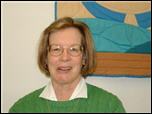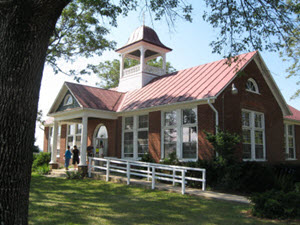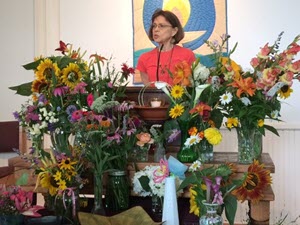
HUU Sermon Archives
Sacred Spaces
Presented by Elizabeth Ihle
May 7, 2006
 This
idea of discussing sacred spaces originated with a UU service I attended in Knoxville
TN in last January. I’ve used nearly the same readings and hymns, but this sermon
is different because I thought there was a lot more to say about the subject than
what I heard and we need to have an HUU sacred space appreciation day. Although
we HUUers are genuinely fond of each other and of our visitors, today I’m not talking
about the magic—the sacredness-- of human interaction but of natural places and
constructed buildings. This is a brick and mortar kind of talk, and that’s why I
have taken the liberty to dedicate this service to the many committed folk who for
over a decade now have given their time and talents to maintaining and improving
our HUU building. They deserve our deepest appreciation and our heartiest thanks.
This
idea of discussing sacred spaces originated with a UU service I attended in Knoxville
TN in last January. I’ve used nearly the same readings and hymns, but this sermon
is different because I thought there was a lot more to say about the subject than
what I heard and we need to have an HUU sacred space appreciation day. Although
we HUUers are genuinely fond of each other and of our visitors, today I’m not talking
about the magic—the sacredness-- of human interaction but of natural places and
constructed buildings. This is a brick and mortar kind of talk, and that’s why I
have taken the liberty to dedicate this service to the many committed folk who for
over a decade now have given their time and talents to maintaining and improving
our HUU building. They deserve our deepest appreciation and our heartiest thanks.
The idea of sacred spaces obviously means different things to different people. The Knoxville minister described natural sacred spaces like the burning bush on the mountain and constructed sacred spaces like King Solomon’s temple and suggested that natural spaces like the bush are holy while constructed spaces like temples are sacred, but for the sake of simplicity I’ll call both sacred. Another way we could examine sacred space is to distinguish between personal sacred spaces and public ones.
As I began thinking about this topic, the question of what purpose does sacred space serve began to nag at me. Somehow a sacred space should comfort the soul. Some questions that I’ll be using in evaluating sacred space this morning are these? Does it honor a deity? Does it inspire? Does it teach? Does it comfort? Does it impress? Now, you may think being impressive is a very shallow requirement, and it might be but just think of people’s strong impulse to convert others to their own spiritual views. The impressiveness of the sacred place has historically been a tool to make that conversion happen. And the final question about the purpose of sacred space—a very practical question --does the space make money? Public sacred space doesn’t last long without money to support it. These questions become especially pertinent when we examine constructed sacred space, and you’ll hear me to refer to them again.
Nature provides many instances of sacred space, though nature speaks more strongly to some of us than others. Mountains like the one we read about in Exodus this morning are often marked as places of special pilgrimages; rivers and bridges become holy; a tree or a rock or a stone sometimes takes on power through which people can connect themselves to something from without.(1) When Watt Bradshaw does a service for us and includes one of his guided imageries where he asks us to go to a personal sacred space, I often return to Lost River State Park an hour from here in West Virginia where years ago I spent a week each summer with my young children. I can remember several moments when I was transported into sacred space, and my most vivid experience involved Pileated Woodpeckers. (Pileated Woodpeckers, for those of you who are rusty on your woodpecker lore, look like Woody Woodpecker on steroids.) While enjoying relaxation and woodland sounds on a warm summer day there, I moved into personal sacred space by seeing a pair of Pileated Woodpeckers fly into a nearby tree, offering me an opportunity to observe them a close range. That place and moment were a gift, an opportunity to connect with the divine. It inspired me to appreciate the creation, taught me about Pileateds, impressed the wonders of nature on me, and even made money for Lost River State Park, in that I returned each summer for many years to come. I’m certain nearly everyone else here can relate similar moments of experiencing natural sacred space—walking on the beach, sailing the Chesapeake Bay, watching a sunset in the Shenandoah National Park—where for maybe just a few instances you felt pulled from your daily life and towards the divine. PAUSE
Let’s now move indoors and think about private constructed sacred space. Having just moved less than five weeks ago and still being very much in the unpacking and organizing stage, I am realizing how sacred just the very idea of an ordered home is. Living out of boxes and wondering every moment where an object is located has made me much more appreciative of the truly sacred value of place and dependability. Yes, a home is a refuge in itself that brings comfort and is in some senses sacred space, but it’s possible to go further. We can have sacred spaces in our homes. HUU member Ginny Holbrook-Heggie taught me several years ago about the value of a home altar, and in my old house I had one in my study that I changed seasonally. It contained a meditation fountain, lights, and treasured objects representing earth, air, fire, and water. Sometimes I had additional sacred spaces like my kitchen, for instance, as I prepared food while listening to music and lighting a candle. These sacred spaces within my home gave me a place to rest my soul every now and then. (And, I’ll confess, my cats thought in their typically egocentric way that the bubbly meditation fountain was a dandy drinking bowl set up just for them.) My new house doesn’t yet have an altar, but eventually it will. Unlike, public constructed space, however, it won’t impress people (because few will ever see it) and it certainly won’t make money.
I’d like to move now to constructed public sacred space and will confine my discussion largely to Western tradition, though I strongly suspect that what has been true about Western—mainly Christian-- sacred space would be replicated in other parts of the world. In the Middle Ages, western Europe, especially France, went through a frenzy of cathedral building in the 1100 and 1200s. The cathedrals were a manifestation of Christian piety, but were quite often dedicated in particular to the Virgin Mary. They have inspired believers for nearly eight hundred years now. Did they teach? Absolutely, the elaborate carvings and stained glass were designed to teach Bible stories and moral lessons to the illiterate peasantry that supported them. Did they comfort? Yes, the cathedrals gave a visual reassurance of a world of riches and solidarity in the world to come. Did they impress? Yes, once again. The cathedral was the center point of the town and offered prestige and served then and to some degree now as a tourist attraction, bringing pilgrims, tourists, and business to the town. They made money and were big business. As tourist attractions today, cathedrals have a lot of competition. In many areas their tourist value has been largely replaced with museums, zoos, sports arenas, and parks, and that probably reflects the declining importance of religion in the lives of many people.
As I researched my topic, I found that many of our constructed Christian sacred spaces are built on the sacred sites of earlier religious traditions, an idea that Dan Brown used in his novel The DaVinci Code. Many of the cathedrals built in the Middle Ages to honor the Virgin Mary were built on sites that previously honored the Earth Mother who over the years has been revered under names such as Isis, Tara, Demeter, or Artemis.(2) In her wonderful account of her own religious pilgrimage, psychiatrist and writer Jean Shinoda Bolen points out Chartres is built on a former goddess site along with at least twenty other cathedrals in France, Germany, and Italy. Glastonbury Cathedral in England is located near a well that honored the earth goddess long before Christianity took over.(3)
Less you think that the Europeans have a monopoly on natural sacred spaces transformed into constructed sacred space, they don’t. Near Santa Fe, New Mexico, the little town of Chimayo has El Santuario, a sacred mud pool. It had been holy ground for the Tewa Indians, a place where they believed that fire and water had combined into sacred ground. Eventually, the water had evaporated, leaving mud which the Indians ate when they needed to be cured. In 1810, a man performing the Stations of the Cross in the hills of Chimayo saw light spring up from the mud hole. When he reached down into the mud, he found a crucifix, which was taken to a nearby church. The following morning, the crucifix had returned to the mud hole. The same thing happened twice more, and at that point the people decided to build a chapel at the spot. To this day, people come to get sacred dirt for curing.(4)
Do our sacred spaces today honor the divine, inspire, comfort, teach, impress, and make money? Well, the answers depend upon the space. Most constructed sacred spaces would definitely honor the divine and to some degree inspire believers, but to what degree do they comfort? It obviously depends on a variety of factors. I suspect that most of them provide the visual comfort of familiarity to the people that frequent them. Do they teach? Yes, but sometimes the lessons of today’s stained glass may be more than what is intended. Most of us have been in churches with Bible stories impressed into stained glass, but underneath those windows you’ll also find a little plaque indicating what family donated the window. I suspect those inscriptions are an unintended lesson, signifying that a family was rich enough to honor a loved one. A number of churches around here so old that they have run out of window space, and families have had to find other ways of memorializing their loved ones. Do churches impress? Leaving out the minister and the programming, do church buildings today impress? Well, it obviously depends upon the church. Unless it’s really sumptuous or architecturally outstanding, I’m not fully convinced that most churches impress folks much today—churches are just too common and look too much alike. As religion has become less important to many people, the ability of constructed sacred space to impress has declined as well. Our final question about a church’s making money sounds a bit ridiculous today. If a church is doing well today, it’s because the service is popular. It’s more likely that the minister and congregation that attract, not the building itself. Most church buildings today are liabilities.
Let’s spend our final few moments thinking about sacred space in connection with our HUU building. Does it honor a deity? Well, we would have some disagreement on this point, but it definitely honors spirituality as UU principles 3 and 4, as printed on the back of our program, state. Does our building itself inspire? Well, probably not a lot, though building says to me that we honor simplicity and practicality. Does our building comfort? I’d guess that many of us find our own HUU building very comforting, mainly because of its familiarity and our memories of experiencing celebrations of life’s transitions like birth, marriage or civil union, and death here. And though my focus this morning has been spaces, not people, I can’t resist saying being able to mix with like-minded people at HUU certainly makes coming here a comfort. Does our space teach? Interestingly enough, our wonderful building history carefully researched by our own Chris Edwards tells us that this site has historically been used for enlightenment, ever since a wooden schoolhouse was constructed here a hundred and twenty-one years ago in 1885. (If this information intrigues you, you can find Chris’s full history on our HUU website.) As literate people, we don’t need to rely on carvings and stained glass to teach our congregation, but our symbol of the chalice, of the light in search of truth, appears in several forms around our sanctuary, as do brochures explaining not only UUism but also various social justice issues. Does our church impress? Well, that’s for each of us to judge, but the building was constructed far more to be practical than impressive. The 1885 school was razed in order to build a modern brick school in 1909 that held grades one through seven. That building is the one we now occupy. There was a room on each side of the central hallway and another at the back. The state was making a major effort to replace wooden schoolhouses with brick ones, and our building was constructed according to a cookie cutter plan supplied by the state. The school, called the Dale Enterprise School, after 1909, was finally a victim to school consolidation when Pleasant Valley School opened in 1963. From then on our building stood empty or was leased for a variety of schooling alternatives until the Lutherans bought the building in 1983. We bought it from the Lutherans in 1994 and added the RE building in 1996. So maybe our building can be impressive since it will soon celebrate its 100th birthday, but we don’t have the fancy stuff that many other churches have. Right now, I think our space is fairly unpretentious, offering an impression of simplicity. But it’s flexible, and I like it. How many other Harrisonburg churches can have a lunch and an ice cream social in their sanctuaries? Our last criterion about sacred space-- making money—is a big one. Since we occasionally rent our building, it does make money but certainly not enough to take care of repairs and fund improvements. We don’t have any tourists to make money from, but that’s the same for most churches today. The luxury of having a building—and before we had this building we rented space first from the local synagogue and later from the OK Corral—is a luxury that our pledges, the hard work of our building committee, and our church members who clean it pay for. We need to honor them.
So as we finish today, let’s realize that sacred space is important in the quality of our daily lives, but it’s not free. Our sacred spaces offer us places to rest our souls. Let’s leave today honoring our individual sacred spaces and appreciating our HUU building supported by our pledges and all the work that our Buildings and Grounds folks have done over the years to keep our communal sacred space maintained and improved.
1Loosely quoted from Christopher Alexander, A Pattern Language, in The Education of the Heart, edited by Thomas Moore (New York: HarperCollins, 1996), p. 130.
2Jean Shinoda Bolen, Crossing to Avalon: A Woman’s Midlife Pilgrimage (New York: HarperCollins, 1994), pp. 24-25.
3Bolen, p. 114.
4Ann Hood, “In Search of Miracles,” The Best Spiritual Writing 2000, Philip Zaleski, ed. (New York: Harper/San Francisco, 2000), pp. 159-168.
Return to Sermon Archives
For the latest sermons and events at HUU, visit our Community Cafe.
Inclement
Weather Policy
Worship
Service Materials


UUs on YouTube
Our denomination has an official presence on YouTube! The Unitarian Universalist Association's YouTube site includes several videos and lots of interesting commentary.
Harrisonburg Unitarian Universalists 4101 Rawley Pike | Harrisonburg,
VA 22801
Mailing Address: | PO Box 96 | Harrisonburg, VA 22803
| (540) 867-0073 | Webmaster
HUU is a member of the Southern
Region of the Unitarian Universalist
Association
Privacy Policy &
Disclaimer
Site Design & Maintainence : Expression
Web Tutorials & Templates


